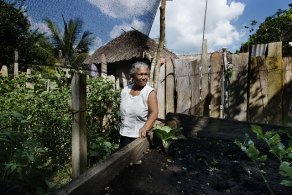What are the challenges of responding to displacement as a problem of transitional justice? In the Colombian context, pervasive violent conflict coexists with constitutional democracy. In recent years, the legal framework for dealing with internal displacement has been altered by the 2011 Victims’ Law. Based on newly published work on Colombia, this blog post discusses the changing conditions for displaced women’s legal mobilization.

Internally Displaced in Colombia. Photo: EC/ECHO/FAO
Imposing the rule of law in post-conflict situations has often been seen as a means of filling normative voids that both enable and result from conflict. Colombia offers a unique opportunity to reflect critically on how progressive legal frameworks — particularly those that formally and extensively incorporate international law — fare in practice.
By early 2014, Colombia had one of the world’s highest populations of internally displaced people (IDPs): 5.7 million. As of July 2014, more than 6.6 million Colombian citizens had registered as victims of armed conflict.
Since 1964, Colombia has been engaged in a protracted civil conflict that has entailed the presence of both communist guerrillas and paramilitary death squads, as well as the devastating effects of counterinsurgency operations (undertaken with U.S. support) and the militarization of the so-called war on drugs. The conflict, waged mostly in the rural areas, has created a massive forced migration from rural to urban areas, where IDPs join the ranks of the urban poor.
Large-scale humanitarian crises typically involve weakened or fragile states, which rely on the humanitarian apparatus of the UN and international nongovernmental organizations (NGOs) to assess and address the crisis.
This is not the case in Colombia, which is a constitutional democracy with a strong administrative state and a steadily growing economy.
- Read more at the blog of the Norwegian Centre for Humanitarian Studies, where this text was posted 16 June 2015.